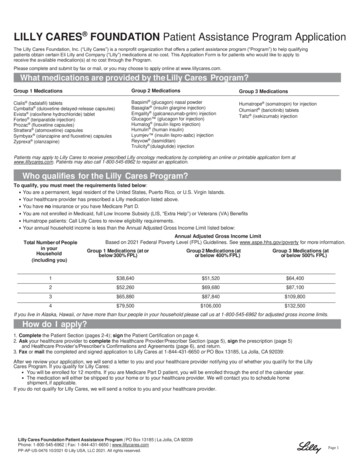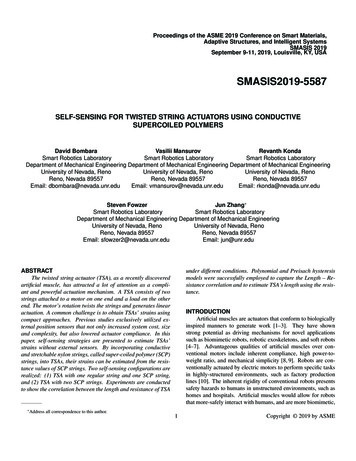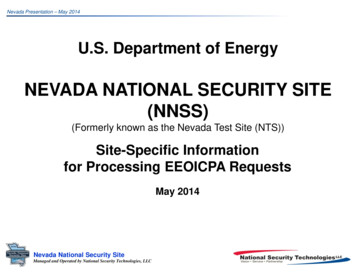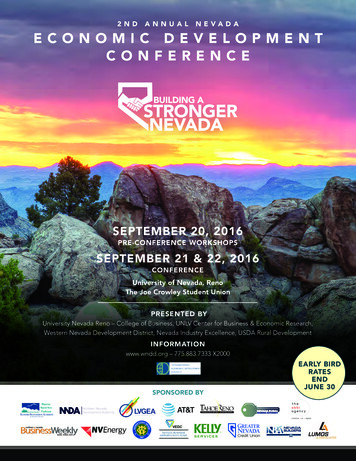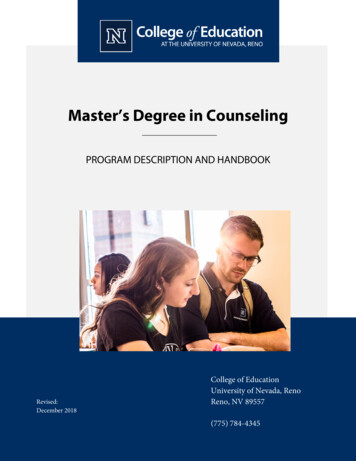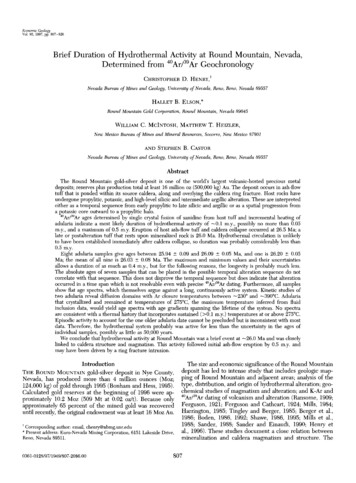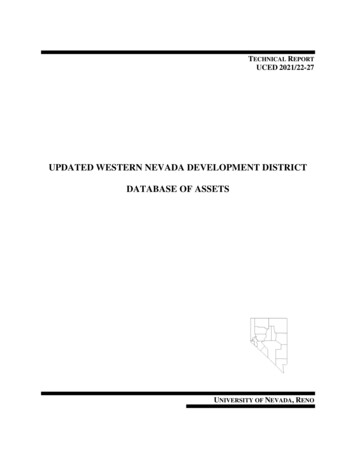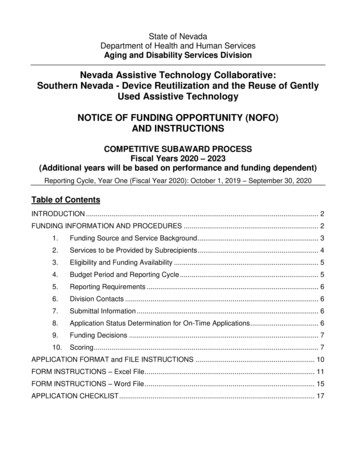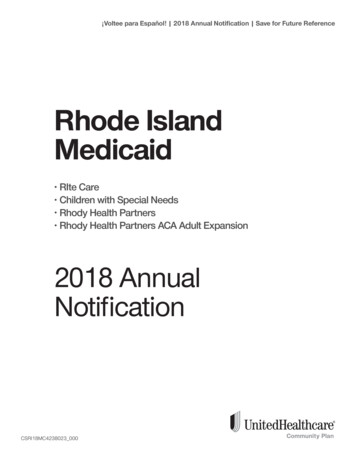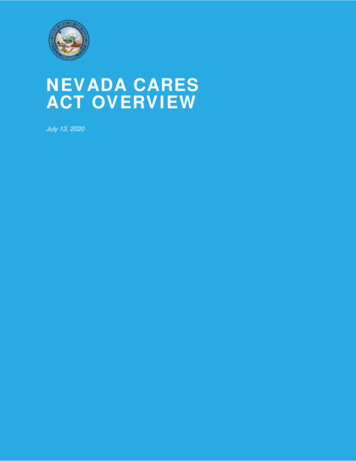
Transcription
NEVADA CARESACT OVERVIEWJuly 13, 2020
NEVADA CARES ACT OVERVIEWCOVID-19 FEDERAL FUNDING SUPPORT FOR STATESIn order to mitigate the impacts of stay-at-home orders and to support eachstate’s efforts to respond to the Coronavirus Disease 2019 (COVID-19)pandemic, the federal government has provided temporary funding throughthe passage of four federal bills. These federal bills were designed to helpstates pay for testing and contact tracing, emergency response, financialrelief to businesses, individuals and families, health care and state and localgovernments including K-12 schools and higher education institutions. opriations Act (HR 6074) — Provided emergency funding forpublic health and health care.Families First Coronavirus Response Act (HR 6201) — Providedsome early assistance to families and temporarily increased the federalmatch for some state programs including Medicaid and In-HomeSupportive Services.Paycheck Protection Program and Health Care Enhancement Act(HR 266) — Expanded funding for small businesses, hospitals,community and rural health centers, and substantially expandedfunding for testing and contact tracing to support reopeningbusinesses and the economy while continuing to be vigilant aboutprotecting the public.Coronavirus Aid, Relief, and Economic Security (CARES) Act (HR748) — Broadened the assistance available including funding forstates, local governments, education, child care, individuals andfamilies. Funding also expanded, extended, and supplementedunemployment insurance benefits. Finally, this measure providedassistance to businesses, including the health care sector, smallbusinesses, farmers, airports, and transit agencies.1
NEVADA CARES ACT OVERVIEWNEVADA AND THE CARES ACTThe Coronavirus Aid, Relief, and Economic Security (CARES) Act economicrelief package provided dozens of temporary federal funding sourcesfor Nevada workers, families, businesses, and communities during thecoronavirus pandemic. This critical funding has been used to support state,tribal and local governments, small businesses, non-profit organizations,working families, and individual Nevada taxpayers.Federal funding has been distributed throughout Nevada from the CARESAct to address public health needs and to fund state and local governmentprograms for children, families, seniors, law enforcement and health careproviders.Part of that funding includes an estimated 1 billion that has or will bedistributed directly to entities within Nevada, including health care providersand community health services, and for programs offered through state andlocal governments to date. The highlights of some of these allocationsinclude: 241 million in direct cash payments to Medicare providers in theState of Nevada to assist in their response to the COVID-19 pandemic. 88 million in grant funding from the Centers for Disease Control andPrevention (CDC) to be used for enhanced testing and contact tracingof coronavirus cases in Nevada. 70 million to health care providers and community health servicesacross Nevada to address costs associated with the coronaviruspandemic. 32 million in funding for Nevada’s Child Care and DevelopmentBlock Grant to help ensure Nevada families have child care optionsduring this public health crisis. 30 million to fund Community Development Block Grants (CDBG),Emergency Solutions Grants (ESG), and Housing Opportunities forPersons with AIDS (HOPWA).2
NEVADA CARES ACT OVERVIEW 8 million to help meet the needs of older adults and people withdisabilities as communities implement measures to prevent the spreadof COVID-19. The grants will fund services including home-deliveredmeals, care in the home, respite care, and other support to families andcaregivers. 7.3 million to help state, local, and tribal law enforcement to respondto the coronavirus. Allowable projects and purchases include, but arenot limited to, overtime, equipment (including law enforcement andmedical personal protective equipment), hiring, supplies (such asgloves, masks, sanitizer), training, travel expenses, and addressing themedical needs of inmates in state, local, and tribal prisons, jails, anddetention centers. 7.2 million in Centers for Disease Control (CDC) funding to helpNevada’s efforts to safely reopen through increased testing capacityand improved contact tracing. 4.5 million to help Native American communities across Nevadamaintain operations and funding for affordable housing programsduring the coronavirus pandemic. 1 million to fund small rural hospitals working to combat thecoronavirus pandemic. 17.5 million for skilled nursing facilities relief funds. 117 million in funding for education under the Elementary andSecondary Education School Emergency Relief (ESSER) funds to assistlocal educational agencies throughout the state and provide supportfor remote learning. 26 million Governor’s Emergency Education Relief Fund (GEER) toprovide educational agencies with emergency assistance as a result ofthe COVID-19 pandemic. 61 million in Provider Relief Funds for “safety net hospitals” treatingMedicaid patients that represent those most in need during the3
NEVADA CARES ACT OVERVIEWcoronavirus pandemic, including low-income communities andcommunities of color. 15 million in vital financial assistance under the Coronavirus FundAssistance Program directly to producers of agricultural commoditiesto give them the ability to absorb sales losses and increased marketingcosts associated with the COVID-19 pandemic. 1.8 million to support the preparedness and response activities andneeds of hospitals, health systems, and health care providers on thefront lines of the COVID-19 pandemic.Outside the CARES Act, Nevada has received over 100,000,000 in federalappropriations and grant funding since the beginning of the COVID-19health crisis to support Nevada’s frontline workers and vital safety netprograms, including some highlights below: 6.5 million in federal funding from the Centers for Disease Controland Prevention (CDC) to support Nevada’s COVID-19 planning,preparedness and response through the Coronavirus Preparedness andResponse Supplemental Appropriations Act of 2020. 2.4 million in grants from the Federal Emergency ManagementAgency (FEMA) to provide food and housing assistance to Nevadanswho need it. 1.9 million in grant funding from the Nevada Substance Abuse andMental Health Services Administration (SAMHSA) to improve access tomental health and substance use treatments during the coronaviruspandemic. 292,206 in federal funding from the U.S. Department of Health andHuman Services (HHS) to Tribal communities in Nevada to providemental health and substance use treatment during the coronaviruspandemic. The Shoshone-Paiute Tribes, Washoe Tribe of Nevada andCalifornia and Pyramid Lake Paiute Tribe each received 97,402.4
NEVADA CARES ACT OVERVIEWCARES Act - Coronavirus Relief Fund (CRF) for State and LocalGovernmentsIn addition to the funding for Nevada under the CARES Act outlined above,Nevada also received an allocation under the Coronavirus Relief Fund (CRF)established under Title V of the Act. This section of the CARES Act authorizeda 150 billion direct allocation to State, Local and Tribal Governments acrossthe country to assist in navigating the impact of the COVID-19 outbreak. TheState of Nevada received the guaranteed small state allocation per Title V ofthe CARES Act in the amount of 1.25 billion.In accordance with the CARES Act Title V, 45 percent of this amount was tobe allocated to local governments and those with populations in excess of500,000 could elect to receive direct payments from the United StatesDepartment of the Treasury (Treasury).Accordingly, Clark County elected to receive a direct payment of 295,004,620, and the City of Las Vegas elected to receive 118,944,280.The remaining amount of 836,051,100 was distributed to the State ofNevada, 148,551,100 of which was received by the State to allocate to thecounties and incorporated cities outside of Clark County with populations ofless than 500,000. After the local governments’ allocations, the final amountleft to the State for its direct spending was 687,500,000.(Sec. 5001) This section makes appropriations for the Coronavirus Relief Fundto make payments to states, territories, tribes, and certain local governmentswith populations of at least 500,000 for necessary expenditures with respectto the COVID-19 outbreak. Expenditures must be incurred between March 1and December 30, 2020, and must be unaccounted for in the budget of therecipient jurisdiction .The Inspector General of the Department of theTreasury must provide oversight of the disbursement and use of these funds.The Governor’s priority is to ensure the State’s limited funding is utilized in amanner consistent with the federal requirements for the use of the CRF thatbolsters the state and local government response to the public healthemergency to protect the lives and health of all Nevadans.5
NEVADA CARES ACT OVERVIEWIt is important to note there are restrictions and prohibitions on the mannerin which these funds may be used. CRF can only be used for certain, limitedexpenditures, as enumerated by Congress in the CARES Act. Eligible costsinclude: Necessary expenditures incurred due to the public health emergencywith respect to COVID–19;Expenditures that were not accounted for in the budget most recentlyapproved as of March 27, 2020 (the date of enactment of the CARESAct) for the State or government; andExpenditures incurred during the period that begins on March 1, 2020,and ends on December 30, 2020.Additionally, Treasury continues to issue updated guidance, including CRFFrequently Asked Questions (FAQ), regarding the use of the CRF dollars. Theinitial Treasury guidance was published on April 22 and has been revised fivetimes, most recently on July 8. Major takeaways from subsequent Treasuryguidance include: Government revenue replacement is not an allowable use of thefunds: Funds may not be used to fill shortfalls in government revenueto cover expenditures that would not otherwise qualify under thestatute. Although a broad range of uses is allowed, revenuereplacement is not a permissible use of Fund payments.Prohibits use of the Fund for payroll or benefits for employeeswhose work duties are not substantially dedicated to mitigating orresponding to COVID-19: Payroll expenses are allowed solely forpublic safety, public health, health care, human services, and similaremployees whose services are "substantially dedicated to mitigating orresponding to the COVID-19 public health emergency."Public health response is included: The guidance also indicates that“due to the public health emergency” includes first order, directresponses (e.g., spending to address medical or public health needs ofthe emergency) as well as second order effects of the emergency (e.g.,6
NEVADA CARES ACT OVERVIEWspending to provide economic support for individuals and businessesthat have suffered impacts from COVID-19). Allowable expensesinclude: Expenses for communication and enforcement by State,territorial, local, and Tribal governments of public health ordersrelated to COVID-19.Expenses for acquisition and distribution of medical andprotective supplies, including sanitizing products and personalprotective equipment, for medical personnel, police officers,social workers, child protection services, and child welfareofficers, direct service providers for older adults and individualswith disabilities in community settings, and other public healthor safety workers in connection with the COVID-19 public healthemergency.Expenses for disinfection of public areas and other facilities, e.g.,nursing homes, in response to the COVID-19 public healthemergency.Penalties & Audits for Misuse of CARES Funds:Title V of the CARES Act subsection (f) assigned the U.S. Treasury Office ofInspector General (OIG) with the responsibility for monitoring and oversightof the receipt, disbursement, and use of funds and recoupment authority ifthe Treasury OIG determines that a State, Tribal government, or unit of localgovernment has failed to comply with subsection (d) of the Act.This unique authority gives Treasury OIG the ability to monitor recipients andestablish reporting and record keeping requirements. To summarize, if anaudit by the Treasury Department determines that a State, Tribal Government,or local government did not use their CARES Act funding appropriately, theyhave the ability to recoup those funds from the entity.For this reason, the Governor’s Office and State agencies have been movingas quickly as possible (under the established interim procedures for theInterim Finance Committee (IFC) whose approval is required) to move funds7
NEVADA CARES ACT OVERVIEWinto specific state agency accounts to respond to the most pressing needsfirst, while following all rules and guidance on the federal funding to ensurecompliance.Coronavirus Relief Fund (CRF): Nevada PlanFollowing is a summary of approximately 576 million in planned uses beforeDecember 30. 2020 from the State’s 836 million distribution in CRF funds,as of July 13:Local Governments: 148.5 million – Distribution to local governments: Per the CARES Act,and Treasury’s per capita allocation formula that governs payments tolarger local governments, Nevada is allocating 148.5 million tocounties and incorporated cities outside of Clark County withpopulations of less than 500,000. A breakdown of the CRF funding tobe distributed to local governments to assist with COVID-19 expensesis available on the Nevada Health Response website. These funds willhelp local governments to manage recuperation efforts, as they can beused for expenses already incurred as well as pandemic-related costsmoving forward. By distributing the CRF to counties and incorporatedcities outside of Clark County using the same population-basedformula that was applied to Clark County and the City of Las Vegas, theState of Nevada is ensuring all local governments receive funds in anequitable manner, as intended by the Federal government.Immediate Public Health Response: 158 million – Support for contact tracing, testing and PPE underNevada’s COVID-19 Outbreak Management Strategy and Concept ofOperations (COP) administered through the State Public Health Lab,the Division of Emergency Management and the Division of Public andBehavioral Health: The purpose of COP is to develop an operationssurge and sustainment capability to prevent the spread of COVID-19and mitigate any outbreak as well as develop a strategy to transition8
NEVADA CARES ACT OVERVIEWstate response to shared public and private partnership utilizingNevada’s public and private health care systems. As the statetransitions from crisis management, Nevada has established six lines ofeffort as a bridge to a normal process: PPE surge capacity COVID-19 specimen collection laboratory testing (PCR and antibody) case investigation and contact tracing preparing vaccination operations Nevada National Guard support 8.5 million – Food Security: Administered by the Nevada Departmentof Agriculture to address food insecurity for Nevadans and relief forNevada’s agriculture and food industries. Funding may be utilized bycommunity organizations and public entities working to reduce foodinsecurity in Nevada during the COVID-19 pandemic, including ThreeSquare Food Bank in Las Vegas and the Food Bank of Northern Nevadain Reno/Sparks. 6.25 million – FEMA’s Cost Share Requirement for Stafford ActAssistance: Treasury Guidance allows for government entities to use theCRF to pay for FEMA’s cost share requirements for the Stafford Actassistance only for COVID-19-related costs that satisfy the Fund’seligibility criteria and the Stafford Act. 3.12 million – WIC Online Grocery Delivery Access Program: Underthe Nevada Department of Health and Human Services, this programis designed to ensure WIC participants are able to have confidentialgrocery delivery so that recipients can remain at home to self-isolateand reduce the risk of contracting and spreading COVID-19. 849,000 – SNAP Pandemic Electronic Benefit Transfer (P-EBT):Administered by the Nevada Department of Health and HumanServices, the Pandemic Electronic Benefit Transfer (P-EBT) was9
NEVADA CARES ACT OVERVIEWapproved by the U.S. Department of Agriculture on May 1. This enablesSNAP recipients to receive groceries delivered to their home. Theallocation of CRF funds allows DWSS to issue additional funds forchildren that are on the National School Lunch Program (NLSP). Thisbenefit will address temporary food needs for approximately 324,850children statewide.Economic Support: Respond to Secondary Effects of COVID-19Emergency 30 million – COVID-19 Statewide Rental Assistance Program:Administered by the Nevada Housing Division in cooperation with theNevada Treasurer’s Office, the program is intended to provide rentalstability to thousands of Nevadans, enabling those individuals andfamilies to avoid eviction and potential homelessness. Such a programwill also reduce the risk of contracting and spreading COVID-19,allowing these eligible individuals and families to remain in a stablehome. 20 million – COVID-19 Statewide Commercial Real Estate RentalRelief Program: To assist Nevada business owners including non-profitorganizations who have lost monthly revenues due to COVID-19 sinceMarch 2020. 480K – The Homeowner Connect Program (THOC): The COVID-19pandemic and the resulting dramatic reduction in economic activityhas had an impact on Nevada homeowners who are now seekingmortgage assistance relief and are struggling to navigate throughconfusing program requirements. Offered through Home MeansNevada, Inc. (HMN), an existing state affiliated nonprofit organization,THOC will offer a free self-service web portal for Nevada borrowersneeding relief at every stage of delinquency; provide on-demandassistance from HUD-certified non-profit housing counselors; and offersystemic support for homeowners who want to retain their homesthrough an end-to-end foreclosure avoidance process and program.10
NEVADA CARES ACT OVERVIEWState Government and Supporting the Response to COVID-19 PublicHealth Emergency 200 million – State Costs and Reimbursement: There are sevenprimary eligible cost categories for use of CRF Funds: medical needs public health needs specific payroll expenses for public employees for servicessubstantially dedicated to mitigating or responding to theCOVID-19 public health emergencyactions to facilitate compliance with COVID-19-related publichealth measureseconomic supportresponse to secondary effects of the current COVID-19 publichealth emergencyany other COVID-19-related expenses reasonably necessary tothe function of government that satisfies the Fund’s eligibilitycriteriaA portion of these funds are included, as allowed under US Treasuryguidance, in the proposed plan to address the state’s historic GeneralFund shortfall in Fiscal Years 2019-2020 ( 36 million) and 2020-21 ( 44million), including funding for payroll costs, administrative leave, andagency expenses to date.In addition, the use of CRF for reimbursement and other applicablecosts impacts other funds, including the Highway Fund.This amount is an estimate as expenditures, costs and eligible categories continue toevolve when continually updated Treasury guidance is issued.11
NEVADA CARES ACT OVERVIEWPriorities for remaining CRF FundsThe COVID-19 pandemic continues to impact the State of Nevada and therest of the nation as the number of positive cases and hospitalizations iscurrently on an upward trajectory. With the constantly changingenvironment, there may be a need to increase funds for proposals outlinedabove. In addition, there are multiple proposals currently under reviewrelated to the State’s public health response, support of the State’s healthcaresystem, education, housing, and the unemployment system, including thefollowing: Estimated 100 million – Funding for Nevada’s health care systemduring the ongoing COVID-19 Pandemic: With the increasing trend inCOVID-19 cases and hospitalizations and based on observations of theexperience in other states, Nevada continues to prepare for theongoing impact of the COVID-19 public health emergency andanticipate that funding will need to be augmented for the testing, PPEand contract tracing under the COP (above), as well as ongoingemergency management. In addition, support for the state’s hospitalswill be needed, including but not limited to surge capacity, PPE andhealthcare personnel, depending on the levels of COVID-19 outbreaksand surges Nevada experiences over the coming months TheGovernor’s Office is working with the Nevada Hospital Association toprovide the necessary, eligible support within the funding available.Estimated 33 million – K-12 Education: Nevada’s education systemmust prepare for the upcoming academic year. Funding requestsinclude testing, PPE and contact tracing for the State’s 17 schooldistricts and public charter school authority for the upcoming schoolyear.Unemployment System: Since February 2020, more than one in fourNevada workers have been displaced statewide, pushing the State’sunemployment rate to 30.1 percent, the highest level ever reported byany state in modern history and generating an unemploymentinsurance caseload orders-of-magnitude higher than anything the12
NEVADA CARES ACT OVERVIEWState has witnessed previously. While other sections of the CARES Actinclude funding for certain unemployment costs, the funding and usesare limited. To the extent allowable under the CRF, Nevada is reviewingoptions for additional support and improvement in the state’sunemployment system with funds available. Ongoing Economic Development Support: As Nevada struggles torespond to the public health needs of its citizens, it is also committedto responding to the secondary economic effects to the State. The CRFfunds allow for certain economic support programs. The Governor’sOffice is working with the Governor’s Office of Economic Developmentand the Department of Business and Industry, as well as regionalpartners to determine the most effective economic developmentprograms with the limited amount of CRF funding to improve thehealth of Nevada’s economy.Shared Priorities for COVID-19 Response: As Governor Sisolak andlegislative leadership continue to review the communities andpopulations most impacted by the current pandemic, they are workingtogether to determine priorities for remaining CRF funds in the areasof education and public health response.13
NEVADA CARES ACT OVERVIEWADVOCATING FOR FEDERAL ASSISTANCE FOR STATE ANDLOCAL REVENUEThe federal funding received by Nevada will not be sufficient to address theState’s fiscal crisis and historic budget shortfall caused by the COVID-19pandemic. Without further assistance from the federal government, Nevadafamilies, businesses and governments will continue to face enormoushardships.The State of Nevada continues to join other states to advocate for federalassistance for state and local revenue shortfalls resulting from the COVID-19pandemic. This economic crisis is forcing states to make painful decisions tocut education, health care and state workforce budgets. Just a few of theseefforts, in addition to updates on federal funding, are noted below: In a May 11, 2020, letter to congressional leadership that Nevadasigned jointly with other western states, state leaders explain thatwithout federal assistance, states will be forced to make impossibledecisions, including whether to cut funding to education or health andhuman service programs so desperately needed during this time, or tolay off or furlough the employees who have been working hard tosupport the State and the people of Nevada during these verychallenging times, while trying to protect the health of themselves andtheir families as well.On May 13, 2020, National Governors Association Chair and Vice Chaircalled on Congress to act on state fiscal relief.“As Congress reconvenes, delivering urgent state fiscal relief must be atop priority. Each day that Congress fails to act, states are being forcedto make cuts that will devastate the essential services the Americanpeople rely on and destroy the economic recovery before it even getsoff the ground.“With widespread bipartisan agreement on the need for this assistance,we cannot afford a partisan process that turns this urgent relief intoanother political football. This is not a red state and blue state crisis.14
NEVADA CARES ACT OVERVIEWThis is a red white and blue pandemic. The coronavirus is apolitical. Itdoes not attack Democrats or Republicans. It attacks Americans. On May 15, 2020, the HEROES Act was passed by the U.S. House ofRepresentatives, and is currently awaiting review by the U.S. Senate.The House passed the 3.5 trillion stimulus bill because theyrecognized that the CARES Act monies are: (1) too limited in dollarvalue; and (2) too limited in scope to keep state and local governmentssolvent. Below is more information on the HEROES Act: Like the CARES Act, the Heroes Act provides fiscal assistance tostates and locals: 500 billion in direct assistance to states and territories;and 375 billion Coronavirus Local Fiscal Relief Fund isprovided to metropolitan cities, counties, and other unitsof general local government. Critically, the Heroes Act allows the 500 billion CoronavirusState Fiscal Relief Fund to be used to replace revenue shortfallsand may be used to cover “foregone revenues not projected onJanuary 31, 2020.”On June 29, 2020, a coalition of state and local organizations, includingthe National Governors Association, the National Conference of StateLegislatures, the Council of State Governments, the NationalAssociation of Counties, the National League of Cities, business groups,labor unions and others wrote a letter to leadership in the Senateadvocating for urgently needed assistance:Previous federal bills responding to COVID-19 provided importantsupport, many through well-established grant programs, yet none allowfor the replacement of billions of lost revenue due to COVID-19. Morerobust and direct stimulus is needed for state and local governments toboth rebuild the economy and maintain essential services in education,health care, emergency operations, public safety and more.15
NEVADA CARES ACT OVERVIEW In its Report to Congress released on June 25, 2020, COVID- 19:Opportunities to Improve Federal Response and Recovery Efforts, theGovernment Accountability Office (GAO) observed the following withregard to funding to state and local governments:The Treasury guidance emphasized that recipients may not use thefunds to fill shortfalls in government revenue, and included examples ofineligible expenses, such as payroll or benefits for employees whosework duties are not substantially dedicated to COVID-19 mitigation orresponse. [511] Organizations representing state and local governmentsexpressed concern to Congress that the economic contraction resultingfrom the pandemic and related closures of non-essential businesses issubstantially affecting their revenues and, without more flexible federalfunding, state and local governments will be forced to drastically cutservices, which could prolong the economic downturn. [512]Nevada has unique structural issues that make it the most vulnerable statein the nation any time the economy takes a hit and while the end of 2019represented a highwater mark for Nevada’s economy - with a historically lowunemployment rate and no projected recession on the horizon - thestructure itself has repeatedly demonstrated vulnerability, with significantoverreliance on casino gaming and other tourism-related taxes.This unbalanced structure is important to note as a primary reason theCOVID-19 pandemic caused the Nevada economy to retrench in suchdramatic fashion resulting in substantial budget shortfalls, the highestunemployment rates of any state in the U.S. and the need for the Governorto declare a State of Fiscal Emergency and to call for a special session of theNevada Legislature.As a result, Nevada has been forced to take deep cuts in services andprograms designed to help many of those most impacted by the COVID-19pandemic. Unfortunately, all COVID-19 federal assistance that has beenprovided to the State thus far, such as CARES Act funding, are prohibitedfrom being used to fill the State’s revenue shortfall.16
NEVADA CARES ACT OVERVIEWWithout additional federal assistance, a slow recovery, or one in whichNevada lags behind the nation, will exacerbate the current economic andfiscal crises facing the State.Additionally, funding will allow the State to restore reductions related toeducation, health and human services, and the state workforce to ensureState government is providing core, critical services to residents.Governor Sisolak joins the National Governor’s Association in strongly callingfor the federal "passage of critical priorities that will help states and territorieslead us through this pandemic response and get America moving again: 500billion in fiscal support for state budgetary shortfalls resulting from thepandemic, enhanced FMAP funding to provide healthcare to our mostvulnerable, and 100 percent federal cost share for FEMA response andrecovery efforts.”###17
for skilled nursing facilities relief funds. 117 million. in funding for education under the Elementary and Secondary Education School Emergency Relief (ESSER) funds to assist local educational agencies throughout the state and provide support for remote learning. 26 million. Governor's Emergency Education Relief Fund (GEER) to
